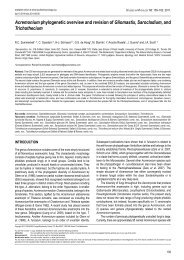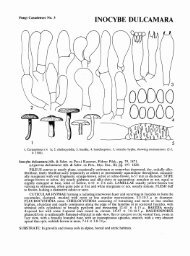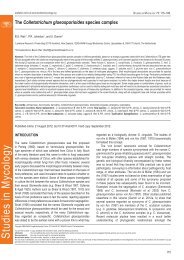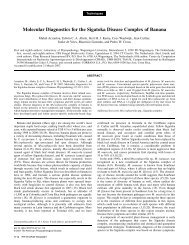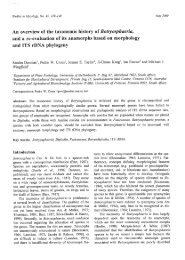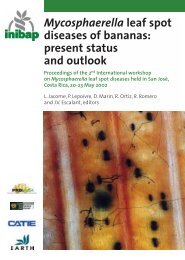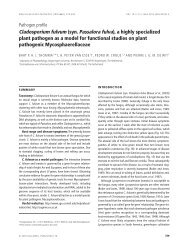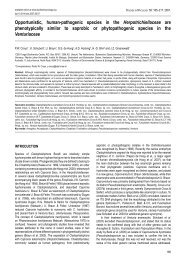Hypocrea rufa/Trichoderma viride: a reassessment, and ... - CBS
Hypocrea rufa/Trichoderma viride: a reassessment, and ... - CBS
Hypocrea rufa/Trichoderma viride: a reassessment, and ... - CBS
You also want an ePaper? Increase the reach of your titles
YUMPU automatically turns print PDFs into web optimized ePapers that Google loves.
HYPOCREA RUFA / TRICHODERMA VIRIDE<br />
4. Conidia (3.0–)3.2–4.0(–4.5) × (2.7–)3.0–3.5(–4.0) μm; conidiophores typically sinuous<br />
<strong>and</strong> frequently branched; phialides short <strong>and</strong> broad, proliferating phialides <strong>and</strong>/or<br />
submoniliform hyphae not formed; endophytic in trunk of Theobroma gileri, Ecuador ................................. Vb 1<br />
4. Conidia larger, (3.0–)3.5–4.5(–8.5) × (2.2–)3.0–4.0(–4.7) μm; not endophytic .................................................. 5<br />
5. Conidia (3.0–)3.5–4.5(–5.5) × (2.8–)3.4–4.0(–5.0) μm, typically globose, grossly<br />
warted, L/W (0.8–)1.0–1.2(–1.5); terminal conidiophores often curved, phialides<br />
often widely spaced <strong>and</strong> solitary, often hooked or sinuous; proliferating phialides<br />
usually not formed in pustules ................................................................................................................. T. <strong>viride</strong><br />
5. Conidia (2.7–)3.5–4.5(–8.5) × (2.2–)3.0–4.0(–4.7) μm, globose to ellipsoidal,<br />
L/W (0.9–)1.0–1.4(–2.0), verruculose; phialides typically forming in whorls,<br />
straight; proliferating phialides <strong>and</strong>/or submoniliform conidiophores often formed ............................................ 6<br />
6. Conidia subglobose, (3.2–)3.5–4.5(–4.7) × (2.7–)3.0–4.0(–4.2) μm, L/W 1.0–1.2(–1.3);<br />
mean of distal part-ascospores 5.0–6.5 × 4.7–6.2 μm; mean of proximal part-ascospores<br />
5–7 × 4–5 μm; colony radius on PDA after 72 h at 25 °C typically 25–33 mm; Australia<br />
<strong>and</strong> New Zeal<strong>and</strong> .............................................................................................................................. T. vinosum<br />
6. Conidia subglobose to ellipsoidal, (2.8–)3.5–4.5(–8.5) × (2.3–)3.0–3.7(–4.7) μm,<br />
L/W (0.9–)1.1–1.4(–2.0); mean of distal part-ascospores 4.2–5.5 × 4.2–4.7 μm;<br />
mean of proximal part-ascospores 4.5–5.5 × 3.2–4.0 μm; colony radius on PDA after<br />
72 h at 25 °C typically 35–45 mm; cosmopolitan, more common north-temperate ...................... T. <strong>viride</strong>scens<br />
7. Conidia globose to ovoidal, smooth, finely warted or with larger scattered warts .............................................. 8<br />
7. Conidia smooth, subglobose, ellipsoidal to ellipsoidal, smooth .......................................................................... 9<br />
8. Conidia subglobose or ovoidal, finely spinulose (often appearing smooth in light microscope),<br />
(2.8–)3.4–3.6(–7.0) × (2.4–)3–4(–6) µm, L/W 1.0–1.7 ....... T. asperellum Samuels et al. (Samuels et al. 1999)<br />
8. Conidia subglobose to ellipsoidal, smooth or with large scattered warts; (3.0–)3.2–4.5<br />
(–5.7) × (2.2–)3.0–3.5(–4.0) μm, L/W = 0.9–1.7 (mean = 1.2) ......................................................................... Ve<br />
9. Conidia globose to subglobose or broadly ovoidal ........................................................................................... 10<br />
9. Conidia ellipsoidal to oblong ............................................................................................................................. 13<br />
10. Conidiophores <strong>and</strong> conidia typical of <strong>Trichoderma</strong>, green <strong>and</strong> typically forming<br />
in abundance on SNA, PDA <strong>and</strong> CMD; colonies fast-growing ........................................................................ 11<br />
10. Conidiophores <strong>and</strong> conidia verticillium-like, forming in wet heads, sparsely formed<br />
<strong>and</strong> very inconspicuous, reliably forming only on SNA .................................................................................... 12<br />
11. Colonies with a strong coconut-like odour; conidia subglobose to ovoidal, smooth,<br />
(2.7–)3.0–3.8(–5.0) × (2.3–)2.8–3.5(–4.0) µm, L/W = (0.8–)1.0–1.3(–1.6); often with<br />
a strong coconut-like odor .................................................................... T. atro<strong>viride</strong> P. Karst. (Dodd et al. 2002)<br />
11. Colonies lacking a coconut-like odor; conidia subglobose to ovoidal, finely<br />
spinulose (often appearing smooth with light microscope), (2.8–)3.4–3.6(–7.0) ×<br />
(2.4–)3–4(–6) µm, L/W 1.0–1.7; rarely with a coconut-like odour .............. T. asperellum (Samuels et al. 1999)<br />
12. Conidia (3.0–)3.5–4.5(–5.0) × 2.5–3.5 μm; colony radius 24–26 mm after 96 h at<br />
25 °C on PDA; growing on Moniliophthora roreri on pods of Theobroma cacao,<br />
Ecuador ........................................................................... T. paucisporum Samuels et al. (Samuels et al. 2006)<br />
12. Conidia (2.5–)3.0–3.7(–4.0) × 2.2–)2.7–3.2(–3.5) μm; colony radius < 15 mm after<br />
96 h at 25 °C on PDA; endophyte in stems of Scalesia pedunculata, Galapagos<br />
Isl<strong>and</strong>s ..............� T. scalesiae<br />
13. Conidia (3.2–)3.5–4.0(–4.5) × 2.5–3.0 μm; Peru .......................................................................... T. neokoningii<br />
13. Conidia larger, (3.2–)3.5–4.5(–4.7) × (2.2–)2.5–3.5(–3.7) μm; Iran or cosmopolitan temperate ...................... 14<br />
14. Conidia (3.5–)3.7–4.5(–5.5) × (2.5–)2.7–3.5(–3.7) μm; L/W (1.0–)1.2–1.5(–1.7);<br />
colony radius on SNA after 72 h at 25 °C typically < 35 mm, north- <strong>and</strong> south-temperate ................... T. gamsii<br />
14. Conidia larger, (3.2–)4.0–5.0(–5.8) × (2.2–)2.5–3.0(–3.2) μm; L/W (1.1–)1.4–1.8(–2.1);<br />
colony radius on SNA after 72 h at 25 °C typically ca. 40–45 mm; Iran ........................................................ Vd 2<br />
147




